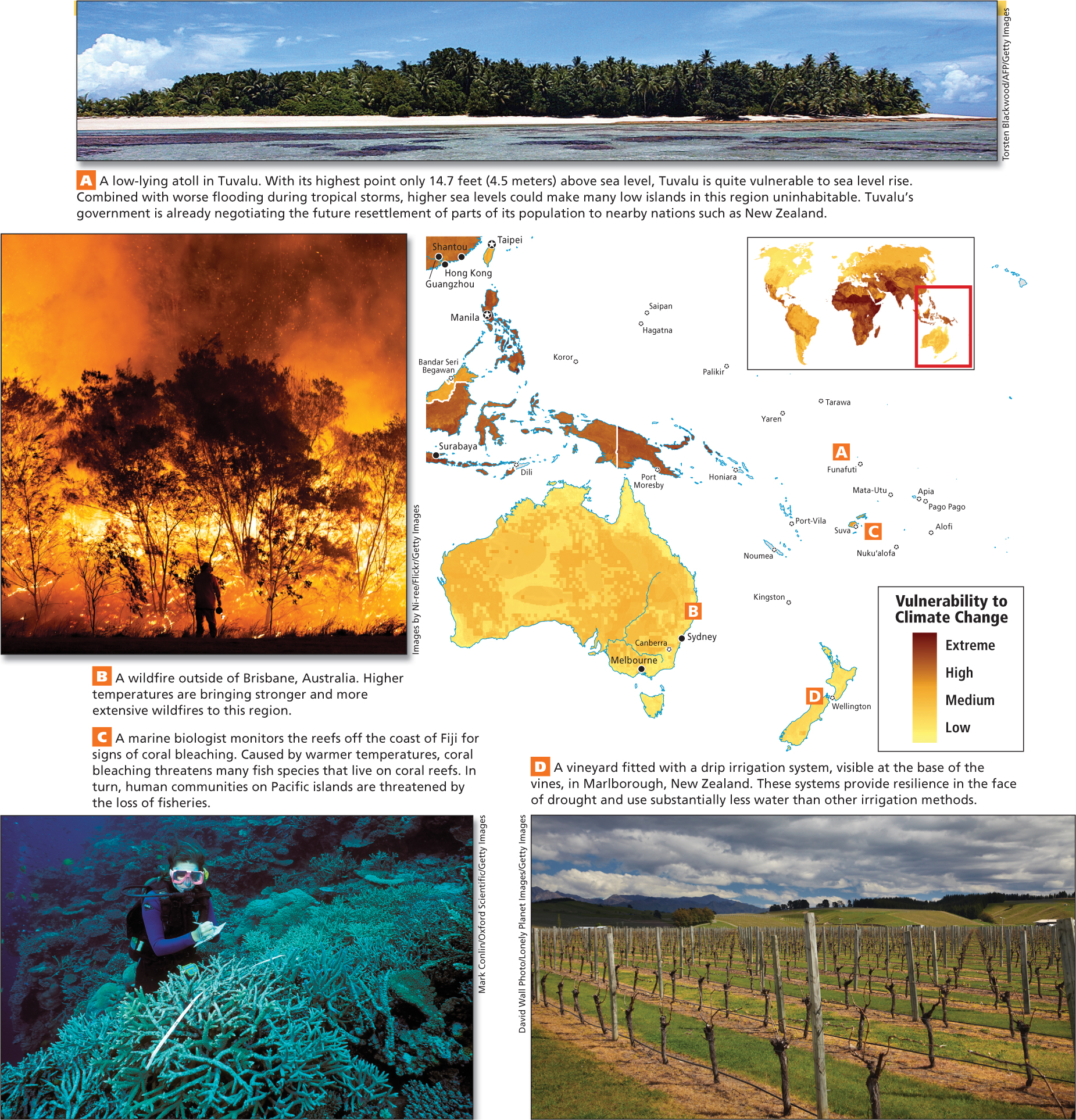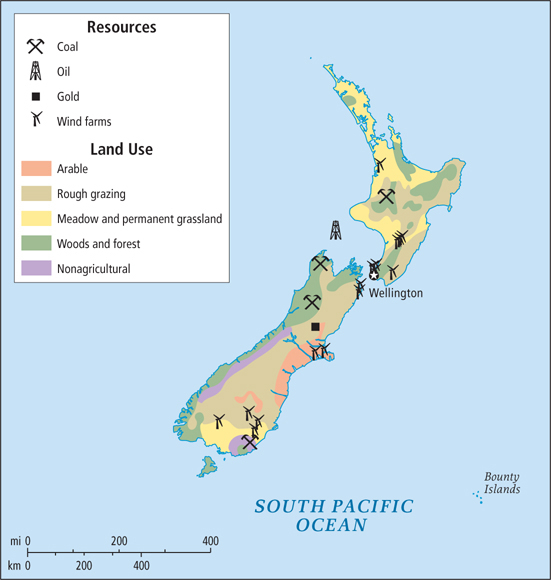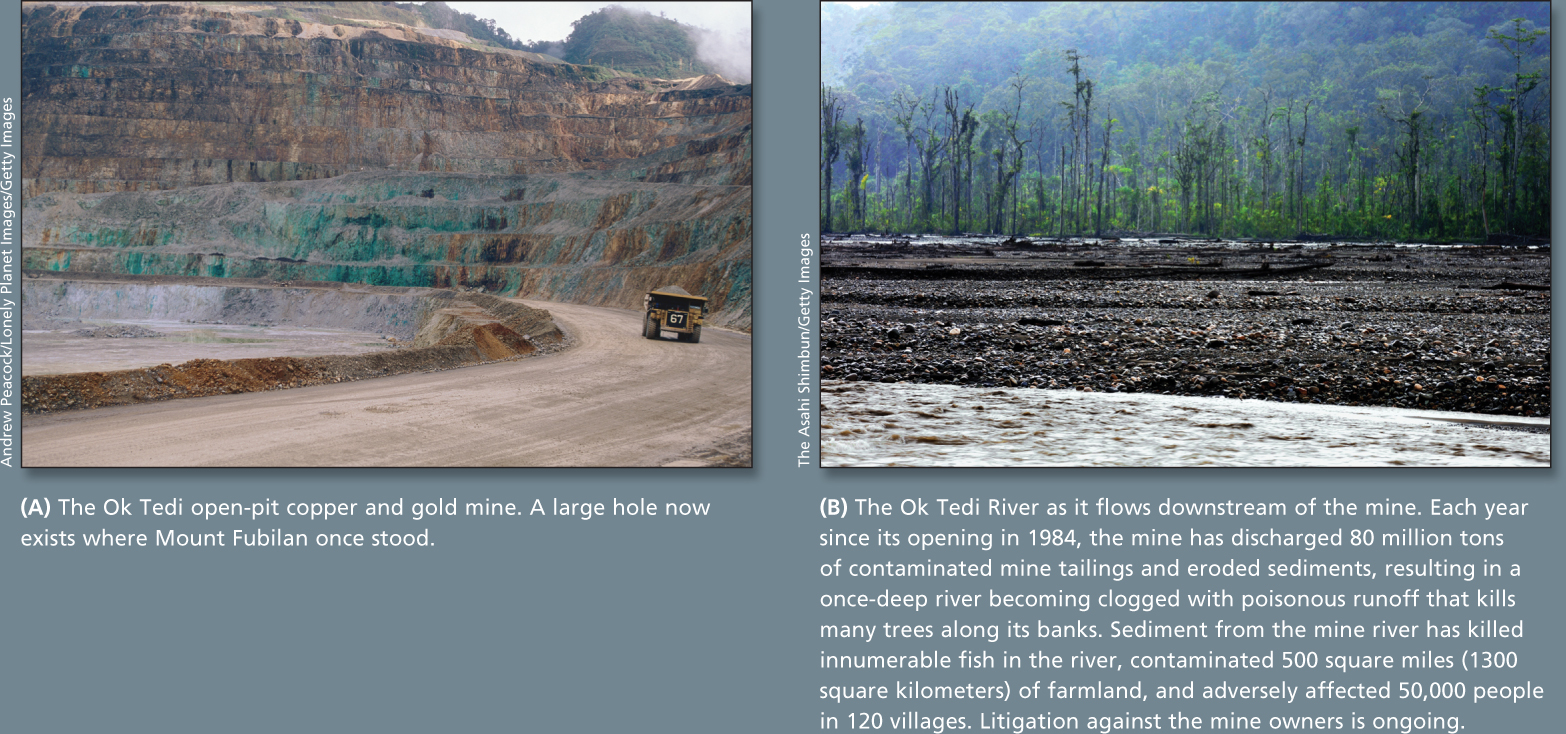11.3 ENVIRONMENTAL ISSUES
GEOGRAPHIC INSIGHT 1
Environment: Oceania faces a host of environmental problems and public awareness of environmental issues is keen. Global climate change, primarily warming, has brought rising sea levels and increasingly variable rainfall. Other major threats to the region’s unique ecology have come from the introduction of many nonnative species and the expansion of herding, agriculture, fishing, and human settlements.
Global Climate Change
Oceania, with the exception of Australia, is a minor contributor of greenhouse gases. Australia has some of the world’s highest greenhouse gas emissions on a per capita basis (see Figure 1.14). Much of Australia’s emissions, like those of the United States, result from the use of automobile-

THINKING GEOGRAPHICALLY
Use the Photo Essay above to answer these questions.
Question 11.1
mhg84goCymyYquHz6S/6rPfTCgWylGP6kP2EGhhhlFpmW/IsmDb4ch0eSv6o/onAaT5C861kNXp/SHg7gxdUeBmyA9EPcpegkho+yyCyo4kjs1LRP8Wi29srWW7A+5FZ1t6Ysu2dZvzux7HQTR9aaHIGt7Pm3n54+ESyfUWy4MsvQo/xJ9o1QXMDYHYWV/boED7IYranLB57ukUcJQqd1L8uCxWGrBqGRBa5WNLygx8S5HdclyoL4aBpzuKLboeQDMzD6iQ37gupo2lzvvW7eLbpMNym/VRFFWklHk86ns2DvlohW5qAnfDhkWypCT6MCtv/RMqxQQV5oehODd3HdA9flOXqyzk0T8g2Fe81wxXQjfUr3s8VWao5PjB3XmUKWg2hog==Question 11.2
OTnfDi1HDe69seFz1zjD+PNaFcE6vXghYO5eI3IXMCBgz5Tizfg0ybC8QQZ0VLbGkBUnvWX454A8+/j5Pcs716XN5P7ZbdI4pVn13arxbVln2YC54cqAZPe2bgTALAhNgfz161IgVQ2JIb6k8YDRvVyWYEnsu7oAAgbLuQ==Question 11.3
JZ1kO1sHze4Ue31LUCI8BtzDadwppI9tSxi36Nqb3kXm5PaFgbqdSQ4cPA0EMsxPZpP/2/6qbH3Yl5/+EQnu2+wZfhobRG8F7ar6T3lei6Jrt2gKMez1oqtvZVjS/RuUSea Level Rise The best scientific research indicates that global warming is raising sea levels mainly through thermal expansion as rising temperatures cause the water in the ocean to expand in size, but also by melting glaciers and polar ice caps. Obviously, this issue is of great concern to residents of islands that already barely rise above the waves (see Figure 11.8A). If sea levels rise 4 inches (10 centimeters) per decade, as predicted by the International Panel on Climate Change, many of the lowest-
Other Water-
As fresh water becomes scarcer across the region, virtual water (see Chapter 1) becomes an issue. All export-
Another concern is the warming of the oceans, which can result in stronger tropical storms. Warmer ocean temperatures threaten coral reefs and the fisheries that depend on them by causing coral bleaching (see Figure 11.8C), a phenomenon that has affected all reefs in this region in recent years, especially the Great Barrier Reef. Because so many fish depend on reefs, coral bleaching also threatens many fishing communities. This is especially true on some of the Pacific islands that have few other local food resources.
Responses to Potential Climate Change Crises Oceania is pursuing a number of alternative energy strategies to reduce greenhouse gas emissions. Although Australia remains dependent on fossil fuel sales (primarily of coal, and also of crude oil and natural gas) to Asia, it is pursuing renewable energy strategies for domestic use. These include increasing power production from geothermal, solar, and biomass sources and, because of water shortages, decreasing the emphasis on hydropower. New Zealand has set a goal of obtaining 95 percent of its energy from renewable sources by 2025. Much of this energy will come from wind power, which has a great deal of potential in this region, especially in areas near the Roaring Forties. On low Pacific islands, solar energy is now the most widely used alternative to costly and polluting imported fuel.
456
457
Invasive Species and Food Production
European systems for producing food and fiber introduced into Oceania have had a profound effect on Oceania’s environments. Many of the unique endemic plants and animals of Oceania have been displaced by invasive species, organisms that spread into regions outside of their native range, adversely affecting economies or environments. Many exotic, or alien, plants and animals were brought to Oceania by Europeans to support their food production systems. Ironically, many of these same species are now major threats to food production (Figure 11.9).

THINKING GEOGRAPHICALLY
Use the Photo Essay above to answer these questions.
Question 11.4
Kh5ygAjVzgFLLukg6nW0XvUUmV7Cgv+HTHEyVG3pv7vyI52dTvedOBV7vIJSu3q62NnRiGDCBvWt5bGQqNtkEF+hQ8H3dqglHuOfXSoI20GuPDEIfV2rhg==Question 11.5
pD36vcwoL+vWd6mU8j/WvVz5ABsxiMaWTy135UhIVGuS3BbNYKIkoZvccYotoJwTTKGy95XhGGeQAnGnVhSCo3cFo0J0RLjLMWF+EV6SrtFQFV7LVXyOzg==Question 11.6
U22sqmIo3GlhprbpUrJV5H+PLiCo7+Z7AhkK1+Q6HPbDMQPvA4SfA063tsvOxNXVWc1VDtVOfCZ9SHnFl9MN2pBjR7Kyt8HE6FXEVGLfwrsQk8pTOmqo+qeXcApi89veMDAPFubyJ9ce9mUJeLowG6/xvXk=Question 11.7
0J80w/cZ961iHCfs1yilRQspObXkdqEdpFH3REh8j3xTWLwtCWEPg7fY5fcWn7dXA5e967UHFwGY0DI+Rcjc81hncZwozNGipUYitHZ8LJ6JerqlNfVbeA==invasive species organisms that spread into regions outside their native range, adversely affecting economies or environments
Australia When Europeans first settled the continent, they brought many new animals and plants with them, sometimes intentionally, sometimes unintentionally. European rabbits are among the most destructive of these introduced species. Early British settlers who enjoyed eating rabbits brought them to Australia. Many were released for hunting, but with no natural predators, the rabbits multiplied quickly, consuming so much of the native vegetation that many indigenous animal species starved. Moreover, rabbits became a major source of agricultural crop loss and reduced the capacity of many grasslands to support herds of introduced sheep and cattle. Attempts to control the rabbit population by introducing European foxes and cats backfired as these animals became major invasive species themselves (Figure 11.10C). Foxes and cats have driven several native Australian predator species to extinction without having much effect on the rabbit population. Intentionally introduced diseases have proven more effective at controlling the rabbit population, though rabbits have repeatedly developed resistance to them.

Herding has also had a huge impact on Australian ecosystems. Because the climate is arid and soils in many areas are relatively infertile, the dominant land use in Australia is the grazing of introduced domesticated animals—
Dingoes, the indigenous wild dogs of Australia (see Figure 11.10B), prey on sheep and young cattle. To separate the wild dogs from the herds, the Dingo Fence—
New Zealand New Zealand’s environment has been transformed by introduced species and food production systems even more extensively than Australia’s environment. No humans lived in New Zealand until about 700 years ago, when the Polynesian Maori people settled there. When they arrived, dense midlatitude rain forest covered 85 percent of the land. The Maori were cultivators who brought in yams and taro as well as other nonnative plants, rats, and birds. By the time of European contact (1642), forest clearing and overhunting by the Maori had already degraded many environments and driven several bird species to extinction.
ON THE BRIGHT SIDE
Water Conservation
Oceania is a world leader in implementing alternative water technologies. Some of these are simple but effective age-
European settlement in New Zealand dramatically intensified environmental degradation. Attempts to re-

Most of the cleared land is used for export-
Pacific Islands In the Pacific islands, many unique species of plants and animals have been driven to extinction as the islands have been deforested and mined or converted to commercial agriculture. This has been the case in Hawaii, which is home to more threatened or endangered species than any other U.S. state, despite having less than 1 percent of the U.S. landmass. The extensive conversion of tropical Hawaiian forests to cropland— 239. HAWAII CONSIDERED AMERICA’S ENDANGERED SPECIES CAPITAL
239. HAWAII CONSIDERED AMERICA’S ENDANGERED SPECIES CAPITAL
Globalization and the Environment in the Pacific Islands
As the Pacific islands have become more connected to the global economy over the years, flows of resources and pollutants have increased dramatically. Mining, nuclear pollution, and tourism are all examples of how globalization has transformed environments in the Pacific islands.
Mining in Papua New Guinea and Nauru Foreign-

THINKING GEOGRAPHICALLY
Question 11.8
yZODMafBhjt2B2M8mIArPPpMupaFBgbbuLT1cg9ZL7/tZ4hAUzzAPEROqiklOANsoPicAO/e5dxGWULxC2VrYqeYTwfQcMmrhMXlDEvHcA+YeyVWeSWhV0FbBulCOTx6WixC45GYPsg0A0yJk0W/26rwg7w4/QlqsozeQnB3Aag7yofeg/ZH7Bd9uV3hYjUhfi55kAjVoVXYCqa3rc827wo1JO3vTAfWnQR5J+2J6UJ/W5ELnWWerFg3DvTvtJko9SbUxztgw5oxGAaFwHGAVJHxANWbjfnWQuestion 11.9
kCksHD0aTTopclCWHWJnGHf7EZZtAzivnfNx3OOvjRmjOb9j8z8kl1F9SnYmIopi+YbKqNyttITTQx4HhIEBTGjpjOigmZWwlzD8/H5qxfiGBbvt1OaN2R7Th26YGhlm0Y/SeshVQ2aF9Bi8xtl3lfW+irjrWHcvF8Orhm99BJ3jXyfiKrbk2g==458
459
ON THE BRIGHT SIDE
Environmental Awareness in New Zealand
New Zealand is a global environmental leader. It formed the world’s first environmentally focused national political party in 1973 and spearheaded the world’s first nuclear-
In 2007, thirty thousand of these people sued the Australian parent mining company, which was then BHP Billiton, for U.S. $4 billion. Two villagers, Rex Dagi and Alex Maun, traveled to Europe and the United States to explain their cause and meet with international environmental groups. They and their supporters convinced U.S. and German partners in the Ok Tedi mine to divest their shares.
The most extreme case of environmental disaster caused by mining took place on the once densely forested Melanesian island of Nauru, which is one-
460
Nuclear Pollution The geopolitical aspects of globalization have hit Oceania especially hard. Nuclear weapons testing by France and the United States from the 1940s to the 1960s (during the Cold War), as well as the dumping of nuclear waste from various nuclear powers, have become major environmental issues for the Pacific islands (see Figure 11.9A). In New Zealand in July 1985, the French secret service blew up the ship Rainbow Warrior owned by the antinuclear environmental group Greenpeace. In response, the 1986 Treaty of Rarotonga established the South Pacific Nuclear Free Zone, which was an expansion of a similar zone set up in New Zealand in 1984. Most independent countries in Oceania signed this treaty, which bans nuclear weapons testing and nuclear waste dumping on their lands. Because of political pressure from France and the United States, however, French Polynesia and U.S. territories such as the Marshall Islands have not signed the treaty.
Tourism Even tourism, which until recently was considered a “clean” industry, can create environmental problems. Foreign-
Tourism has also strained island water resources because of showering, laundering, and other services that consume fresh water. Furthermore, inadequate methods of disposing of sewage and trash from resorts have polluted many once-
The Great Pacific Garbage Island When oceanographer Charles Moore found himself surrounded by a massive floating island of plastic garbage in the north Pacific in 1997, he thought it was an anomaly. But his investigations revealed that the disposable, throwaway aspect of modern living was responsible. The island included plastic beverage bottles and caps along with Lego blocks, trash bags, toothbrushes, footballs, and kayaks—
The UN Convention on the Law of the Sea Based on the idea that all the problems of the world’s oceans are interrelated and need to be addressed as a whole, the United Nations Convention on the Law of the Sea (UNCLOS) established rules governing all uses of the world’s oceans and seas and has been ratified by 157 countries (although not the United States). The treaty allows islands to claim rights to ocean resources 200 miles (320 kilometers) out from their shores. Island countries can now make money by licensing privately owned fleets from Japan, South Korea, Russia, the United States, and elsewhere to fish within these offshore limits. As of yet, however, there is no overarching enforcement agency, and protecting the fisheries from overfishing by these rich and powerful licensees has turned out to be an enforcement nightmare for tiny island governments with few resources. Similarly, it has proven difficult to monitor and control the exploitation of seafloor mineral deposits by foreign mining companies.
461
 241. ENDANGERED HAWAIIAN MONK SEAL POPULATION CONTINUES TO DECLINE
241. ENDANGERED HAWAIIAN MONK SEAL POPULATION CONTINUES TO DECLINE
 242. NEW SPECIES OF UNDERSEA LIFE FOUND NEAR INDONESIA
242. NEW SPECIES OF UNDERSEA LIFE FOUND NEAR INDONESIA
 243. SCIENTISTS WARN OF DEPLETION OF OCEAN FISH IN 40 YEARS
243. SCIENTISTS WARN OF DEPLETION OF OCEAN FISH IN 40 YEARS
THINGS TO REMEMBER
GEOGRAPHIC INSIGHT 1
Environment Oceania faces a host of environmental problems and public awareness of environmental issues is keen. Global climate change, primarily warming, has brought rising sea levels and increasingly variable rainfall. Other major threats to the region’s unique ecology have come from the introduction of many nonnative species and the expansion of herding, agriculture, fishing, and human settlements.
In an effort to combat global warming, renewable energy alternatives to fossil fuels are being pursued across the region. New Zealand has set a goal of obtaining 95 percent of its energy from renewable sources by 2025.
Throughout Oceania, the introduction of food production systems from elsewhere has resulted in the spread of ecologically and economically damaging invasive plant and animal species.
Globalization and the patterns of consumption by people who live far from the Pacific are seriously affecting human and animal life in this region.